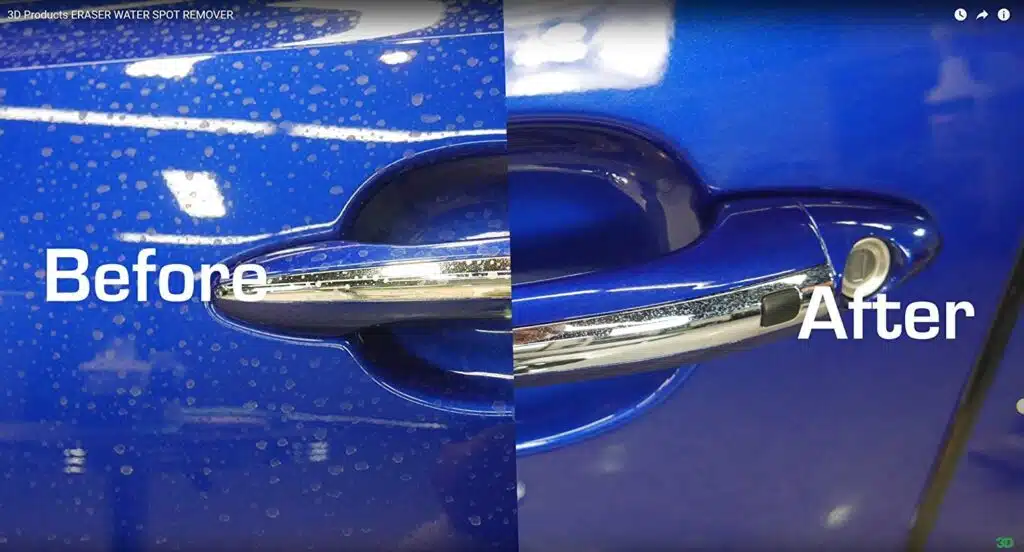
Etching doesn’t solely happen due to water spots—things like insect residue, bird droppings, and acid rain can also cause etching to your vehicle’s finish. But how does etching actually occur? We’ll dive into the science behind it, starting with the example of a water spot.
From mineral deposit to stain
When a water spot dries on your car’s surface, it leaves behind mineral deposits similar to a coffee stain. These are usually easy to wipe away because they haven’t bonded with the finish yet. However, if the spot is left in the sun for a prolonged period, UV rays cause a reaction that helps the minerals bond to the surface. While a chemical treatment can break the bond, you may also need to use mechanical methods, such as claying and buffing, to eliminate the stubborn residue.
From stain to etch
If a water spot isn’t removed during the stain phase and continues to sit under UV rays, the minerals begin to bond with the surface. Over time, the UV radiation can alter the pH level of these minerals, making the surface more susceptible to damage. A solution with a high or low pH can then begin to break down the surface, resulting in an indentation or etch mark. Similarly, acidic substances like insect remains, bird droppings, acid rain, and even leaves can also damage the finish by eating away at the surface.
Removing Water Spots
New water spots
If you notice a water spot early, while it’s still just residue on the surface, you can easily remove it using a quick detailer spray. Just ensure you use a soft, microfiber cloth to prevent any scratching or abrasion.
Stubborn water spots
If a water spot is left untreated for too long, UV rays will bake the mineral residue into the surface. At this stage, you’ll need a more powerful solution, such as an insect remover or tar remover, to break down the minerals. Follow the same method as before, but be cautious not to apply too much pressure while using the microfiber cloth.
If that doesn’t work, you can try increasing the acidity by using a 1:1 solution of white vinegar and distilled water. Let the solution sit for a few minutes before wiping it down. Be sure to do a quick wash beforehand to remove any loose debris so you don’t scratch the surface while wiping.
Etched or stained water spots
This occurs when prolonged UV exposure causes the mineral residue to bond with the paint, creating a stain that is flush with the surface. As the exposure continues, the chemical reaction increases the stain’s alkalinity, eventually causing it to etch into the paint and form a concave mark. Once this level of damage has occurred, it will be very difficult to remove without using mechanical decontamination and significant abrasion.
Although a ceramic coating can provide some protection and delay this process, even highly resistant coatings are still vulnerable to etching. To remove these spots, use a clay bar to treat the affected area, then buff it out with a random orbital buffer. Begin with a soft pad and the least aggressive polish, gradually increasing the intensity if the stain persists. If you’re unsure about performing this process yourself, it’s advisable to consult a professional detailer to handle the job.
Because removing stained or etched water spots requires heavy abrasion, it will inevitably wear down a portion of your clear coat. If the damage is severe enough to cause clear coat failure, the best solution would be to have the affected area resprayed to restore the finish.
Preventing Water Spots
When water beads dry on your vehicle, they can leave behind water spots that can stain or even etch the surface. Once that happens, machine buffing may be required to remove them, which could result in losing a layer of your clear coat or wearing down your ceramic coating, requiring reapplication. To avoid this, here are some effective ways to prevent water spots on your car:
Opt for a Coating That Repels Water
The most effective way to prevent water spots is by using a coating that either sheds water beads or causes the water to sheet off. If water doesn’t remain on your finish in bead form, it can’t leave a mark. While no coating can completely prevent water from touching your car’s surface, those that offer the best water resistance will significantly reduce the formation of static water beads and, in turn, minimize the chances of water spots.
Opt for Distilled Water When Washing
Water spots are formed by the minerals left behind by water beads on your car’s surface. On a hot day, if you’re using regular tap water, water beads can quickly dry into spots before you even have a chance to dry them yourself. Alternatively, you might miss a bead while drying, leading to a stain in a hard-to-reach area. By using distilled water, which is free from minerals, you can avoid this issue altogether—no minerals means no residue or water spots.
Dry Completely
While distilled water might not always be available, the next best thing is to ensure thorough drying after washing. Make sure to dry every area of your car carefully, leaving no beads behind. Pay attention to every corner and crevice to prevent any leftover water from turning into spots.
Avoid Exposure to Rain & Sprinklers
Water is everywhere, and two common culprits for water spots are rain and lawn sprinklers. These can damage your car if it’s parked outside and not immediately cleaned off. The best way to prevent this is by parking your car in a garage or using a car cover when it’s not in use. Additionally, applying paint protection film (PPF) can help shield your car from water exposure, although it’s important to note that PPF can still be prone to staining or etching over time.
ABC: Always Be Checking (for Water Spots)
It may seem like a lot of effort, but to maintain a flawless finish, regular inspections of your vehicle for water spots (and other potential contaminants like stains or etches) are essential. The idea is simple: catching water spots early prevents them from causing permanent damage. Additionally, keep an eye out for other substances like insect residue, road tar, and tree sap, as they can also cause stains or, in some cases, etching.
Wrapping up
Water spots are bound to happen, but with the right ceramic coating, preventive measures, and constant attention, you’ll be able to tackle any that come your way. Paint protection film is one of the most effective solutions to ensure your vehicle’s paint stays protected and in pristine condition.
